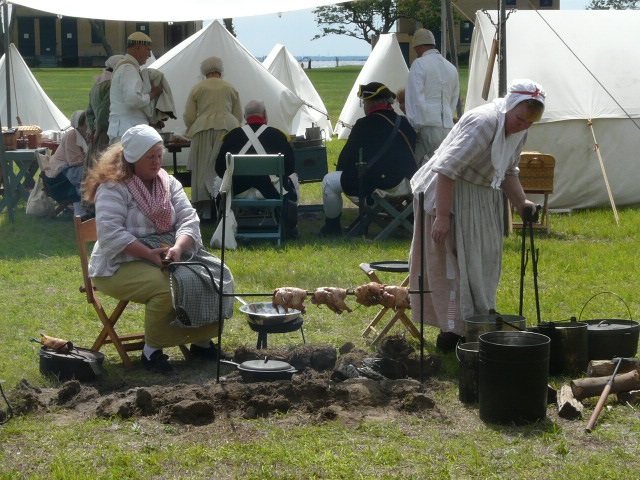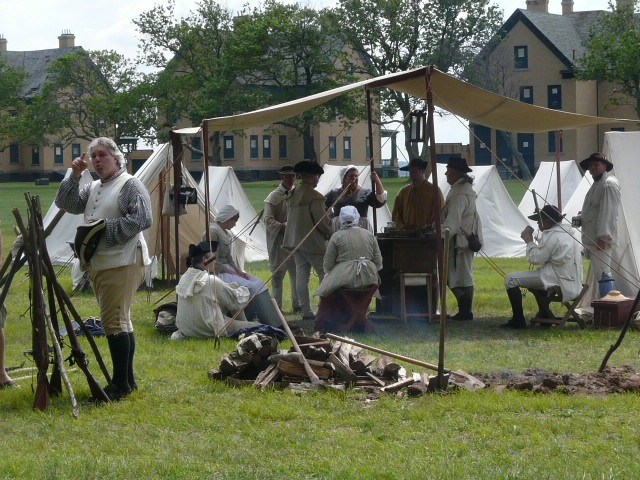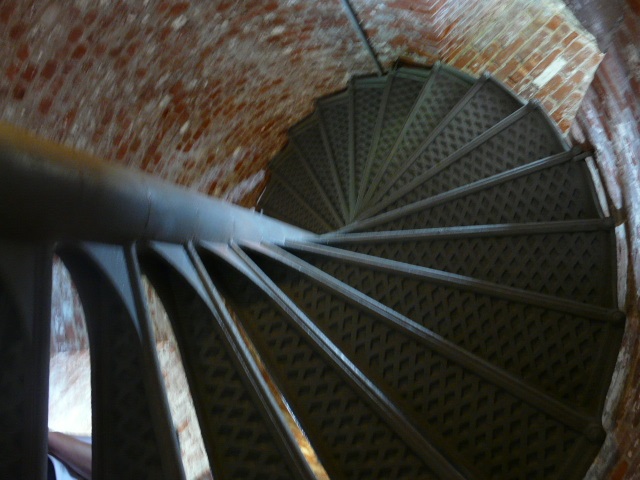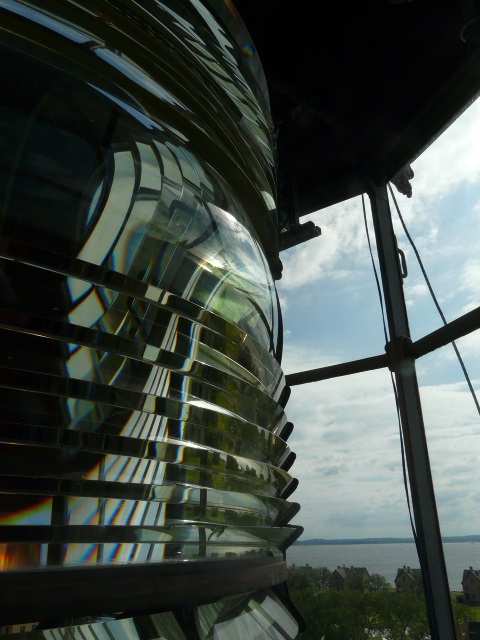by Peter R. Halas and Bill Dunn
with photos by Catherine Schwier
Sandy Hook Lighthouse celebrated its 250th anniversary June 14, 2014. Representatives of Sea Girt Lighthouse participated in a full-day of events on the grounds of America’s oldest lighthouse, first lighted June 11, 1764, and still active.

The festivities began with The Fifes and Drums Band of the Old Barracks in Trenton performing Colonial era marching music. The music, a passing schooner under sail, children’s games, many exhibits and re-enactments of American Revolutionary War battles took several hundred visitors back in time to Colonial America.
Dressed in period costumes, enthusiastic volunteers recreated family life as it was over two centuries ago as they tended a flock of sheep and chickens, worked a garden and cooked meals over an open fire. Youngsters in attendance were encouraged to join in the fun by playing the games that children played in Colonial times, such as hoop rolling, ring the hob (ring toss) and Scotch hopping (hopscotch).
Re-enactors in the colorful uniforms of the Continental Army and the British Army staged the battles fought during the Revolution for control of Sandy Hook Light, which ultimately fell into British hands. Sandy Hook Lighthouse was the fifth of 11 lighthouses built in the Colonial era, but it is America’s oldest, surviving lighthouse. The original Boston Light – the first lighthouse built in the American Colonies – was destroyed in the Revolution.

Visitors to Sandy Hook had the opportunity to explore the keeper’s quarters and climb the tower’s 95 steps up the spiral staircase and then the 9-rung ladder to the very top of Sandy Hook for the spectacular view it offered of the New Jersey Coast and the entrance to New York Harbor.
Patriotic red, white and blue bunting hung from the railing of the gallery that surrounds the lantern room. Wayne Wheeler, president of the U.S. Lighthouse Society, gave an enlightening presentation on the life of a lighthouse keeper and the history of Colonial lighthouses.
Sea Girt Lighthouse Display
Popular bonus features that day were the displays of the U.S. Lighthouse Society, the New Jersey Lighthouse Society and Sea Girt Lighthouse. Volunteers from each group exhibited historic photos, artifacts and literature and talked about their respective missions.
Jude Meehan, vice-president of the Sea Girt Lighthouse Citizens Committee, and SGLCC member Catherine Schwier, represented Sea Girt Lighthouse. Both are knowledgeable and experienced docents, who frequently give Sunday tours at the lighthouse. But this Saturday of the Sandy Hook anniversary celebration, as a steady stream of people visited their display, Jude and Catherine gave brief summaries of Sea Girt Lighthouse’s colorful history, answered questions and invited all to come to the lighthouse to see for themselves.
On the front of a long table they hung a banner with a photo of the lighthouse by trustee Robert S. Varcoe. Colorful signal-code flags, similar to the type issued to Sea Girt Lighthouse in 1898 for communicating with passing ships, were displayed at the Sea Girt exhibit. Atop the table was a model of the lighthouse, a few other artifacts and historic photos including one from the lighthouse collection of the cruise ship Morro Castle afire three miles offshore September 8, 1934. And there were stacks of the 4-page lighthouse history pamphlet that ranges from the station’s first lighting in 1896 to present day. Also displayed was a copy of the recently published book Sea Girt Lighthouse: The Community Beacon.
Sea Girt Lighthouse was the only lighthouse represented under the green-and-white tent, which was pitched in a central spot by the keeper’s quarters. Jude estimated some 300 people passed by the Sea Girt table. “We had a wonderful time,” he acknowledged. “We were pleased to represent Sea Girt Lighthouse on the historic occasion of Sandy Hook’s 250 anniversary and to have the opportunity to talk to so many friendly and interested people about our lighthouse of distinction.”

Catherine noted Sandy Hook Lighthouse directors, museum docents and National Park Service rangers of the Gateway National Recreation Area, where Sandy Hook is located, were most welcoming and appreciated Sea Girt Light’s involvement. She added: “Everyone that day – rangers, volunteers and visitors – were drawn to Sandy Hook by a deep sense of its historical importance. And there was an appreciation for the many other lighthouses in our state that together guided mariners in their journeys and thereby contributed to the economic and population growth of our nation.”
Sandy Hook to Sea Girt
Construction of Sandy Hook was financed by two lotteries authorized by the Provincial Congress of New York and a tax on ships entering the Port of New York. The lighthouse was proposed and promoted by merchants and manufacturers of New York City, who had lost valuable cargo when several ships wrecked in the treacherous shallows off Sandy Hook. The tower and its beacon not only warned mariners of the shallows and the narrow channel but guided them through the channel to New York Harbor.

The Revolutionary War demonstrated the importance of Sandy Hook and New York Harbor, which both sides fought to control. Fearing a British invasion, in March 1776, the New York Congress ordered the light to be extinguished and the lens removed. Having survived many battles, Sandy Hook Lighthouse in June of 1776 came under the control of British troops who rigged a replacement light. Continental troops under the command of Captain John Conover then bombarded the tower, using cannons mounted on several small boats. Cannonball damage can still be seen on the stone of the lighthouse.
In the wake of America’s gaining its independence, Sandy Hook was equipped with a new lens and relighted. Realizing the importance of lighthouses, not only to the young nation’s economy but also the nation’s security, President Washington federalized lighthouses. The Ninth Act of the first Congress established the U.S. Light-House Establishment to plan, build and run America’s lighthouses.

“As commercial ship traffic in and out of the harbor increased tremendously after 1800, so did the need to better mark the sea approaches leading to the Port of New York,” according to Tom Hoffman, a National Park Service ranger and the historian at Sandy Hook.
Less than five miles south of Sandy Hook are the 200-foot-tall Highlands of the Navesink, where the Light-House Establishment built Twin Lights in 1828. The present, taller towers replaced the original towers in 1862. And 44 statute miles south stood three successive Barnegat Lights, located at the 40th parallel, a crucial change point in transatlantic navigation. The first Barnegat Light, activated in 1835, collapsed in 1856 because of beach erosion. It was replaced by a temporary tower and that was replaced by the current tower, Old Barney, lighted in 1857.
Despite the powerful beacons of those lights, mariners in fog and storms often encountered a dark space around Sea Girt where they were unable to see the beacon of Barnegat to the south and Twin Lights and Sandy Hook to the north. That is why Sea Girt Lighthouse was built. It was lighted December 10, 1896, illuminating the dark space.
An 1898 Light-House Establishment map, one of the earliest to show Sea Girt Light, identifies some two dozen aids to navigation along New Jersey’s coastline and up the Delaware River. They formed a constellation of lights, each with a distinct beacon signature that enabled mariners to identify where they were in their journeys. One light guided sailors to the next light and on to their destination.